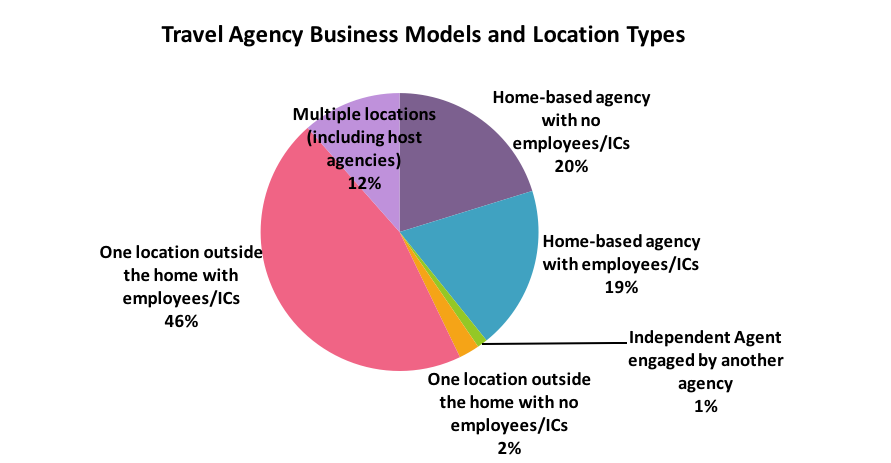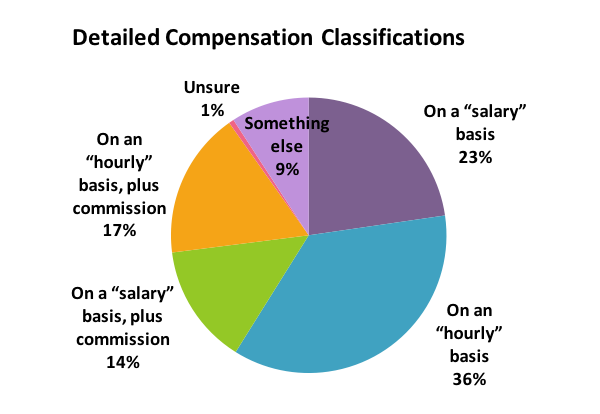Part of the American Society of Travel Agents’ (ASTA) wide-ranging benchmark reporting program, the annual Labor and Compensation report seeks to discover current employment trends and compensation models in the travel agency industry. Insights into compensation packages and classifications, recruitment of travel agents as well as agencies’ plans to handle the new Department of Labor (DOL) overtime regulations can be beneficial to various industry segments related to travel agencies.
Travel Agency Business Models and Location Types
Among ASTA members, the most common models are agencies with one location outside the home with employees or ICs (46%) accounting for the largest share, followed by home-based agencies with no employees or ICs (20%), home-based agencies with employees or ICs (19%) and agencies with multiple locations (12%) in 2016.
Although business models and business needs largely dictate an agency’s location type, modern day technology and remote capabilities allow some agencies to have more flexibility to utilize employees or ICs without necessarily needing a conventional brick-and-mortar store front or an office location. This is especially true for small agencies with more cost constraints. Hence home-based agencies, with or without employees or ICs, are a popular location type with a combination of almost 40% of share.

Compensation Packages
As the business climate improves post-recession and the travel and tourism industry continues to thrive globally despite isolated geopolitical incidents, many travel agency owners and managers indicate that good, experienced agents are in high demand to fulfill increased business needs.
In 2016, ASTA agency members with multiple employees reported compensating their employees on an hourly basis (36%) as the top compensation model, followed by salary basis (23%). Hourly plus commission comes in at 17%, with salaried plus commission at 14%.
New Department of Labor Regulations
At the time of survey in summer 2016, two-thirds (66%) of overall survey respondents indicated that they had heard about the new Department of Labor regulations scheduled (at the time) to go into effect on December 1, 2016, raising the minimum salary threshold for salaried workers to $47,476. (The new rules are being challenged in court and their fate remains unclear.) But only one-third (34%) of them were either very concerned or somewhat concerned as another third (32%) indicated that the new regulations did not affect their business model.

However, if agency owners and managers are required or have decided to begin tracking each salaried employee’s work hours every week, four in ten (39%) expressed that the extra work required is either very burdensome or somewhat burdensome.
Meanwhile, about one-third (32%) of agencies that responded to this survey also indicated that they had one or more employees on their payrolls that were paid on a salary basis whose total annual compensations (including bonuses and commissions) last year were less than $47,476. Therefore, those undecided agency owners and managers will have to make necessary decisions and changes soon in order to comply with DOL’s new regulations (assuming they go into effect).
Getting a sense of how your industry colleagues are compensating employees and independent contractors in our ever-changing industry is an example of the critical business intelligence and business development insights ASTA’s research program provides.
Take a look at what ASTA has to offer, ranging from labor issues to GDS usage to financial benchmarking, at ASTA.org/Publications. And don’t forget that ASTA membership includes preferential pricing for these reports, and in some cases complimentary access. Support your national trade association and join ASTA today!
 Kevin serves as Director of Research and Industry Affairs at ASTA since 2015. He is responsible for supporting the development and execution of ASTA’s wide-ranging government and industry affairs and research agenda for the travel agency industry and the broader travel and tourism industry as well as association issues generally. He also assists in monitoring industry issues and trends that affect travel agency businesses and in representing association members to suppliers and other industry groups through ASTA’s Research Family program and the information from ASTA’s benchmarking series reports.
Kevin serves as Director of Research and Industry Affairs at ASTA since 2015. He is responsible for supporting the development and execution of ASTA’s wide-ranging government and industry affairs and research agenda for the travel agency industry and the broader travel and tourism industry as well as association issues generally. He also assists in monitoring industry issues and trends that affect travel agency businesses and in representing association members to suppliers and other industry groups through ASTA’s Research Family program and the information from ASTA’s benchmarking series reports.
Kevin brings to ASTA over 20 years of professional experience with over 12 years in the travel and tourism industry, including at the U.S. Travel Association and Choice Hotels International, where he frequently shared research insights and information at conferences and seminars with his expertise in managing quantitative and qualitative research studies, projects and programs.
Kevin earned his M.B.A. from the George Washington University and is a certified Project Management Professional (PMP).



